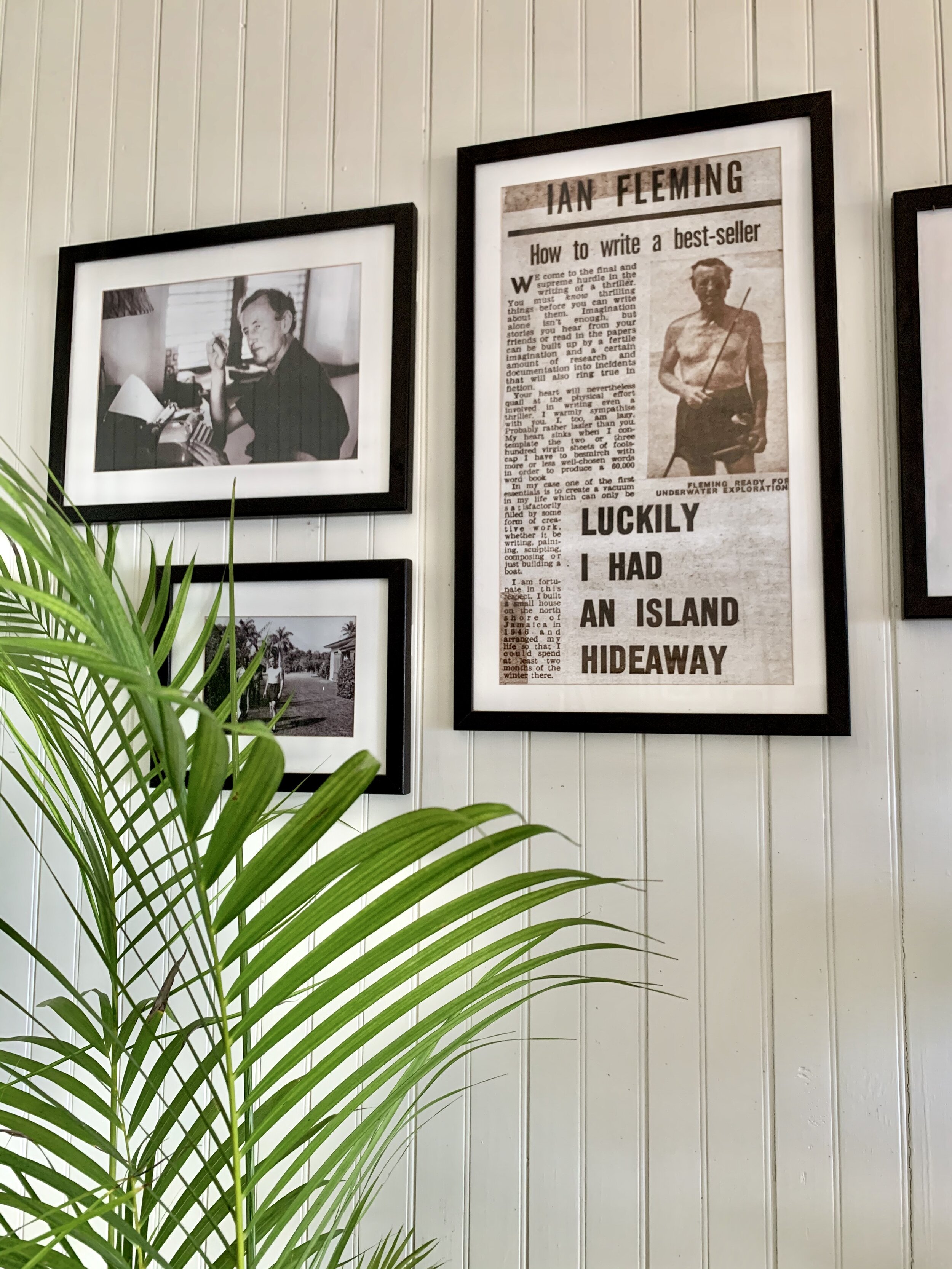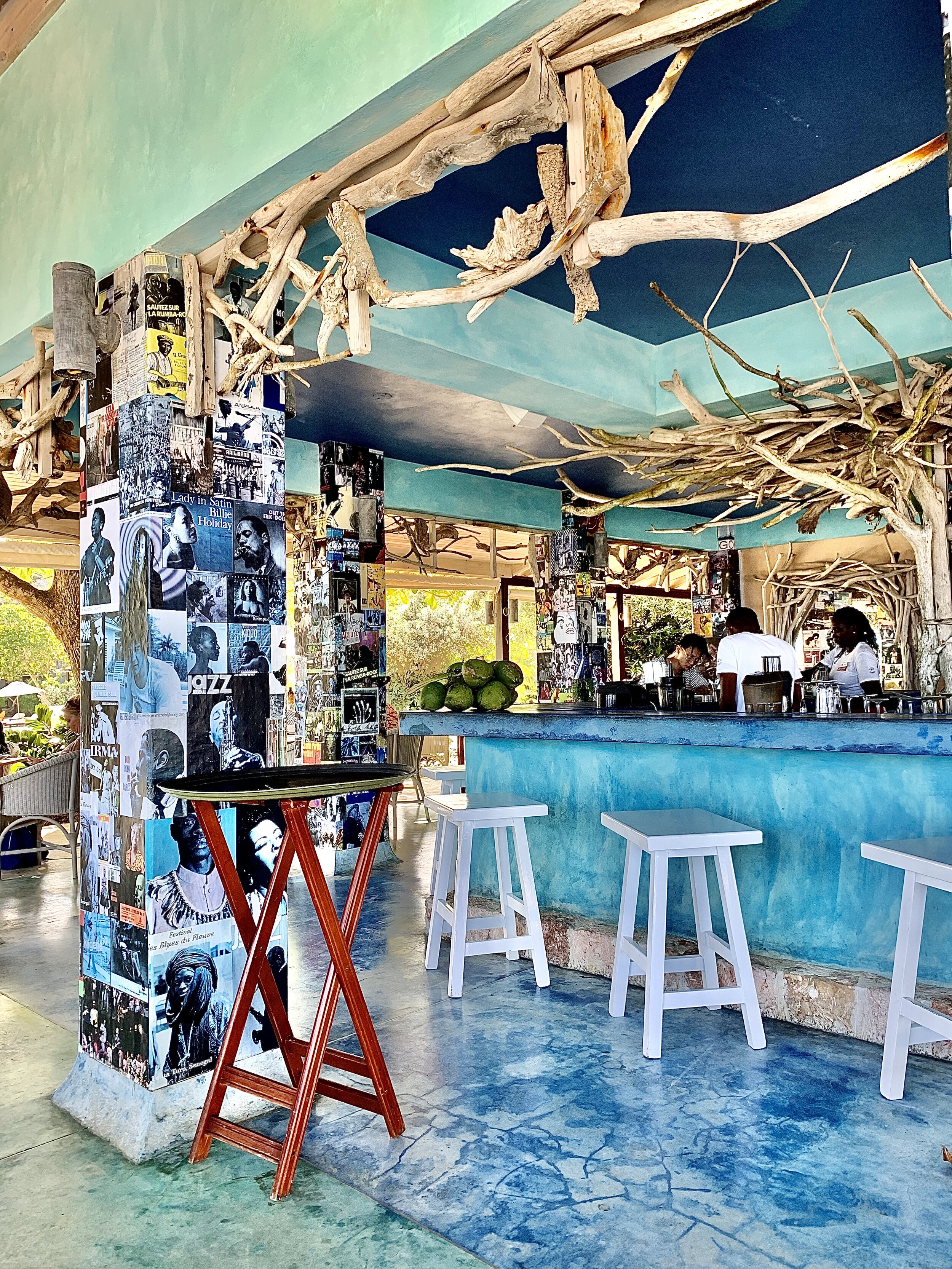Perhaps best known as the creator of James Bond, Ian Fleming was an enigmatic character himself. Stationed on Jamaica during a stint in Britain’s naval intelligence service, Fleming fell in love with the island and vowed to return. He bought a plot of land on the island’s north coast, in the town of Oracabessa, where he built the villa that would be the birthplace of the fiction world’s most notorious spy. Today, the villa and a few dozen one-bedroom cottages form the Goldeneye resort (named after Fleming’s original mission).
Ian Fleming at Goldeneye
Welcome drinks at Goldeneye
We were greeted with a frozen rum & pineapple welcome drink at the resort’s bar, overlooking the rather wild and rocky coast. Our cottage was well-located between two of the resort’s beaches in the midst of tropical plants and singing birds, and there was a complimentary bottle of rum from Chris Blackwell, the current owner of Goldeneye and the founder of Island Records, which was instrumental in the commercial success of reggae music worldwide. On our first evening, the resort organised a happy hour with several complimentary rum-based cocktails that put everyone in the best of spirits.
Each morning, following 17F’s (Ian Fleming’s code name) favourite breakfast of scrambled eggs on toast accompanied by reggae music, we walked along the beach to the eponymous saltwater Goldeneye pool, open to the Caribbean splashing on the rocks and into the pool. Shaped as an eye, this quickly became my favourite spot, and I whiled away hours alternating between reading and gazing at the sea.
The Goldeneye pool
Breakfast reggae at Goldeneye
Kayaking and stand up paddleboarding are offered free of charge, and we took out a kayak to the nearby James Bond beach, where Dr. No with Sean Connery was filmed in 1962. The beach was full of locals barbecuing, teens posing for selfies, and children splashing in the shallows, and we felt right at home. We decided to forego the beach barbecue back at Goldeneye in favour of some local fare, so we drove into town. Chris’s in Oracabessa had just the ticket on the menu: fried chicken, which we enjoyed back on the beach while listening to the roar of the crashing waves.
Kayaking near Goldeneye, Oracabessa
Local posing for photos at James Bond beach
We also spent a couple of nights by the beach in Negril, in Jamaica’s western end, for comparison. The beach there is long, and unlike Jamaica’s north coast, there are no rocks or reefs as you enter the water, making for easy swimming well suited to families or young children. We picked up a Jamaican rum cake at the local supermarket and watched as the sun dipped into the water. Our best meal of the trip was to come later that evening at The Lodge restaurant at Tensing Pen, where we tried the Jamaican specialties of ackee (poisonous if not properly prepared!—quite the adventurous national dish) and jerk chicken, as well as crusted snapper. All were excellently prepared, but the snapper was the standout, gently cooked so that flakes peeled off as soon as it was touched.
Driving from Kingston to Negril
Sunset, moon and planets from Rick’s Cafe, Negril
Another spot well worth a visit is Rick’s Cafe, further south along the coast. Go in the afternoon to test your appetite for risk at jumping points of different heights along the cliff, from which you plunge into the warm sea below. Perhaps you will be lucky enough to see resident ninja Spider, who regaled us with jumps from the highest platform that would not have been out of place at the Olympics. The place was packed on a late November afternoon, with a live band playing reggae classics and sungoers downing Rick’s punches as the sun went down. We stayed and danced until evening settled, and the cafe emptied out until the next day, when the same spectacle would repeat.
The view from Strawberry Hill
Unfortunately, many of Jamaica’s other natural wonders, such as YS Falls and Dunn’s Falls, are hidden behind $25 USD admission fees. That price begs a several hours-long commitment, so if you’re like me, and hoping to arrive early or late to avoid the crowds, you’re out of luck. Instead, en route back to Kingston to catch our flight, we stopped at the Strawberry Hill Resort to enjoy the spectacular views over a drink. The climate is notably cooler, and the rain-fed vegetation even more lush. Be warned that the road from Kingston is a narrow and curvy one (ignore Google Maps’ impassable recommended shortcut route and ensure you stay on the main road), made worse by the form of driving practiced in the country. It’s a free for all: cars drive at full speed in the middle of the road, and often it’s left up to you to get out of the way. At night, the majority of drivers leave their long beams on the entire time, blinding each other in a crazy game of chicken.
Perhaps, behind the wheel of James Bond’s Aston Martin DB5 from the film Goldeneye, I would not have minded in the least.
Sunset from Strawberry Hill










